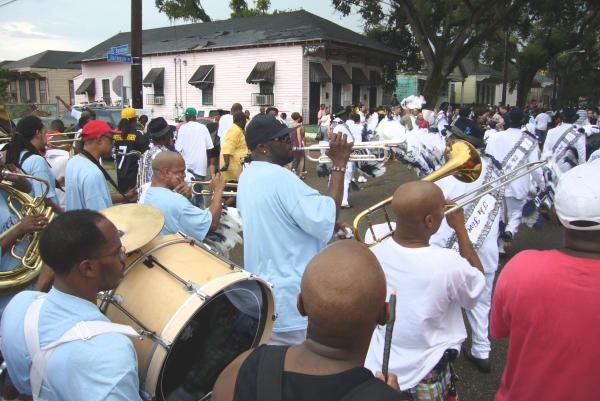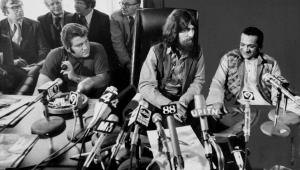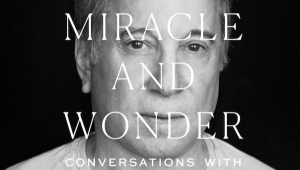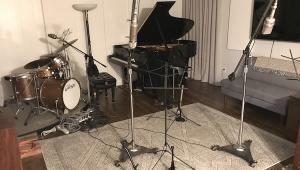New Orleans Culture at a Tipping Point Part 2
New Orleans' second-line parade culture and Mardi Gras Indian culture share a number of attributes.
Both emerged as casually formalized neighborhood practices in the post-Reconstruction decades of the late 19th-century, with Indian imagery likely influenced around that time by the popularity in the U.S. of traveling 'Wild West' shows.
And while otherwise demonstrating a decided preference for brightly colored, conventionally tailored Sunday suits and hyper-shiny, patent-leather footwear, New Orleans' Social Aid & Pleasure Club members will frequently rely on decidedly Caribbean imagery, holding small, decorated umbrellas or wearing gaudy, frilly sashes, but especially wielding enormous fans made of long and colorfully dyed feathers.
New Orleans second-line culture also shares one other notable characteristic with the culture of Mardi Gras Indian 'masking'—it has a history of attracting violence.
While shootings associated second-line parades have been fairly well documented at least since the beginning of the second half of the 20th century, they generally represent violence best understood as the kind of friction that might occur at the edge of any large family gathering, where overheated teenagers who harbor a grudge against one each other find themselves in close contact, which they take as an opportunity to 'settle the score.'
The 2006 Martin Luther Kind Day commemorative and homecoming parade was mostly a grand success. Organizations within the city united behind a common purpose and citizens of various stripes turned out in significant numbers, while the event admirably struck a note that communicated both solemn respect and celebratory progress.
As the parade detoured by both the Superdome and a cemetery site to honor survivors and the dead, holiday-minded crowds began to collect on Orleans Avenue to both acknowledge the parade and reclaim home turf, many having returned to New Orleans from exile in far-off locales just for this weekend and especially for this event.
And then, near the end of the parade, there was a shooting. As might be expected, this incident involved hot-headed teenage boys engaging each other in a series of escalating threats that resulted in guns being drawn but, fortunately, no one being fatally injured.
That much, in its own way, was not remarkable.
What was remarkable was the police response, which closed down the remaining parade, cordoned off the entire length of Orleans Avenue, ordered all participants and observers to disperse, and informed anyone who asked that Orleans Avenue was, for now, off-limits to everyone, including all pedestrians.
And in the following months, another couple of small-scale second-line parades, where violent incidents also occurred, where similarly shut down.
Then, in a much-publicized incident, police arrested two well-known local musicians in the Tr'm' neighborhood one night for deliberately and solemnly playing a popular hymn, 'I'll Fly Away,' in honor of a fellow musician who'd recently become the unfortunate and innocent victim of drug-related violence himself.
But most critically, the police attack on local culture in New Orleans that ramped up considerably in the wake of Hurricane Katrina soon thereafter began to take the form of punitive tariffs on Sunday-afternoon second-line parades.
Following incidents of violence at three post-Katrina parades, police announced their intention to raise the cost of official permits traditionally required of each of these backstreet celebrations.
These parade permits had, in fact, been a long-standing custom in New Orleans, a sort of 'gentleman's' agreement between the local police and the parading second-line clubs, with clubs agreeing to alert police of their intention to hold a parade and police agreeing to provide a minimal parade escort, ostensibly in the interests of public well-being and safety.
For many years, the cost of permits had been set at a flat $600 regardless of the size of the parade or the size of the crowd it anticipated attracting.
This amount may not seem like much in terms of today's dollars, but it represented enough of a financial burden on local parading clubs—who also pay for costumes and hire a marching brass band for four hours— that supporters of second-line culture had been trying to find a way for years to raise money to offset them.
In the late fall of 2006, however, the police unit assigned to overseeing the permits submitted a formal proposal to the city's police chief detailing a plan to increase the number of police personnel assigned to each parades and begin charging fees based on itemized personnel budget for each event that could run as high as $4,500 for a single parade.
After considerable discussion within the parading club community, volunteer representatives of the American Civil Liberties Union subsequently challenged the proposal in federal court, and the result was an out-of-court settlement specifying a sliding-scale fee depending on the intended size of the parade and running from $2,000 to $3,000 for each event.
While leaders of the second-line coalition inevitably read this as a significant victory (thinking they had, at least, negotiated with the police, and negotiated them down), the truth was that parade permits increased to a cost between $2,000 and $3,000 unquestionably represents the kind of economic disincentive to activity that any savvy politician would regard as unfair and punitive.
Looking for Political Advantage, Targeting a U.S. Senate Seat
Like the unofficial campaign of police harassment directed toward New Orleans' indigenous street culture that rose to the surface in the wake of Hurricane Katrina, the political attack on the demographic base supporting that street culture began to take shape just before the hurricane made landfall.
Two elections in the fall of 2002 were critical to this part of the story. In the first, a relatively unknown executive running the local Cox Cable franchise, the city's sole cable TV provider, methodically developed fairly widespread name-and-face recognition thanks to 'town hall' appearances on 'consumer-oriented' segments aired frequently in the local market.
Ray Nagin was clearly positioning himself to enter politics in a wide-open race that followed the two-term incumbency of Mayor Marc Morial, himself the son of New Orleans' first black mayor, Ernest 'Dutch' Morial, another two-term mayor.
But Nagin was a different breed of black candidate, emerging not from several decades of sustained political struggle and internecine political dynamics. Instead, he represented a fairly recent genre of New South business exec, smooth, apparently above racial politics, mostly looking for a faster way up the socio-economic ladder.
If Nagin was unusual in the history of New Orleans mayoral candidates, even more so was his 2002 victory. Relying to a much lesser extent on inner-city black support than any of his predecessors, Nagin focused instead on courting the city's business interests, many of them white, and even succeeded in establishing a small base of support among the city's old-line bluebloods, many of them ultra-white.
Democrat Mary Landrieu's campaign for re-election to the U.S. Senate by Democrat Mary Landrieu—the daughter of New Orleans' first post-Civil Rights mayor, Maurice Edwin 'Moon' Landrieu, a man best remembered as the first New Orleans mayor to welcome blacks into meaningful City Hall positions—was much more conventional.
During her first term in office, Landrieu firmly established herself as a political pragmatist and ideological centrist willing to productively compromise on 'meat-and-potatoes' issues that affected her state, such as oil drilling royalties for offshore drilling that had been for decades woefully underpaid.
But because she is from New Orleans, her support across the rest of the state has remained spotty, and the deciding factor of black New Orleans voters helped her win two very close elections. But, that was only part of what made her 2002 re-election notable.
Even though conservative Republicans have pretty much dominated national politics since the 1968 election of Richard Nixon, the party's hold on majorities in both chambers of the U.S. Congress has been far more tenuous.
Following a 'surge' campaign by former Speaker of the House Newt Gingrich in the mid-1990s, Republican control had begun to slip again, even with the election of a Republican president in 2000.
And in the Senate, where Republicans were barely able to hold onto a 51-49 majority after the 2002 elections, strategists began targeting seats they thought they might have a good chance of capturing in 2008.
Enter Mary Landrieu, old-school Democrat, who squeaked by in her first election on a barely discernible victory margin of only 12,000 votes, and won re-election in 2002 with better but-not-outstanding effort, winning only 52 percent of all votes cast. And this in a state that voted heavily Republican in the past two presidential elections.
But Landrieu's seat is important to Republicans for another reason than simply winning or maintaining a Senate majority.
The Senate's parliamentary protocol says that a 60-vote majority can override opposition to a bill and is enough to have it passed, over minority objection, to the Presidential for his signature to make it a law.
If the Democrats win the presidential race this fall and continue to build a strong majority in the House, a 60-vote majority in the Senate would make the Republicans nearly irrelevant. And after so many years in control, that could be hard pill to swallow.
A Case of Katrina-related 'Voter Dislocation'
At what point it became clear to Republican strategists that the devastation of Hurricane Katrina could actually work to their political advantage will probably not be known for years, if not decades.
But looking back from three years into the post-Katrina rebuilding, it's become painfully obvious Republicans have played this disaster so the stronghold of black New Orleans Democratic voters would be weakened to the greatest extent possible.
Unfortunately, that stronghold of black New Orleans Democratic voters also contains the demographic foundations for New Orleans street-culture traditions.
Probably most convincing evidence of Republican political intent can be found in the clear disparity in the amount of federal aid delivered in the months after the storm to the neighboring states of Mississippi and Louisiana—especially when calculated on a per-capita basis—the first with a Republican governor and the second with a Democratic governor in office.
But even more telling, and influential, has been the political advantage gained in the failure to assist black New Orleans residents, many lacking resources to return and rebuild, some having been evacuated in a FEMA-sponsored airlift operation to diverse and far-flung locations around the country.
Political observers, searching for the least-sensational language possible, have now come to describe this as 'Hurricane Katrina-related voter dislocation.'
The statistical outcome of this 'dislocation' has been stunning: a 15-percent drop in Louisiana Democratic voters statewide, and within the city of New Orleans, a dramatic shift from the 67-percent black majority, in place for more than 30 years, to the 50-50 parity between black and white voters reflected in the most recent mayoral election.
And the fallout of this political recalculation? A frustrated Democratic governor's decision to opt out of running for re-election. The subsequent election of a young, reform-minded Republican (of Hindu descent, but with a Louisiana upbringing) considered enough of a rising star to have been repeatedly mentioned as a potential running mate in the current Republican presidential campaign and has already become a surrogate spokesperson for Republican candidate John McCain.
Then, for the first time in 30 years, the election of a white majority on the seven-person New Orleans City Council.
And then, of course, there's the Senate seat currently occupied by Mary Landrieu.
Her opponent in what Republicans hope will be a hotly contested race? Louisiana State Treasurer John Kennedy, a former Democrat convinced to switch parties just for this election by Karl Rove, strategist supreme of the Republican National Party.
His platform for this campaign? Shamelessly taking a page from what now appears to be a history-making presidential bid by Illinois Senator Barack Obama, Kennedy is touting himself as the anti-establishment candidate, the outsider promising 'change you can believe in.'
"Change is carrying the day," Kennedy told supporters during his campaign kick-off in July. "If you want to change the Senate, you've got to change the senator."
Which brings us to the thematic glue—the 'key' message—uniting various political and social factions around the Republican-initiated transformation of New Orleans in the post-Katrina rebuilding era that presents such a dire threat to neighborhood-based African-American culture.
It's a campaign theme as old as the country itself, but also one that's achieved wide currency in contemporary American politics. When deployed in the American South, however, and especially in a place where the Old South continues to persist to such a great extent, it carries a distinct resonance.
What we're taking about here, obviously, is the chicken-and-egg political narrative of corruption and reform. The main thing about the corruption-and-reform narrative is that it's essentially a con game, a device used essentially to divert attention away from something more profound and more important that's going on at the same time.
Conservatives and libertarians have deployed the old corruption-and-reform soft-shoe to great success over the past four decades, blaming government for erosions of American society caused in reality by the undue influence of corporate interests.
And they've developed a debate trick based on this kind of argument that has become a mainstay of contemporary conservative argument: the straw man gambit. You say you're unhappy? Well, just take a look at how big, old, nasty government's been intruding on our lives!
Never mind that four consecutive decades of conservative dominance and the deliberate dismantling of nearly all forms of government regulation have led the country to a state of what is essentially social and economic chaos.
End Part II

















































